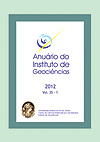The Vieira river debris flow in Teresópolis, southeastern Brazil: characterization of the source area of the transported sediments
DOI:
https://doi.org/10.11137/2012_2_152_164Abstract
This work has presents the geology of the bedrock and the sedimentary deposits of the upper course of the Vieira river where a debris flow killed 23 people on January 2011. The upper course of rio Vieira has drawn a straight line and is embedded in a N25E trending fracture and fault system. Over the almost 2 km of exposed bedrock, there is a predominance of gneissic Cordeiro and Serra dos Órgãos suites. The granite of the Nova Friburgo suite occurs only in the river head and in a narrow strip in the middle section of the channel. Three types of sedimentary remnants were observed: a) talus deposit with granite boulders in the river head; b) gneissic rock fall deposits near the the channel walls; c) granite boulders and gneissic blocks in the floodplain. The presence of granite boulders at the head and the scarcity of the granite in the bedrock indicates that the bulk transported solids comes from the erosion of talus deposits in the headwaters of the river. The blocks of gneiss comes from rock-fall deposits along the channel walls.Downloads
Download data is not yet available.
Downloads
Published
2012-12-01
How to Cite
Rodrigues, J., Tupinambá, M. and Amaral, C. (2012) “The Vieira river debris flow in Teresópolis, southeastern Brazil: characterization of the source area of the transported sediments”, Anuário do Instituto de Geociências. Rio de Janeiro, BR, 35(2), pp. 152–164. doi: 10.11137/2012_2_152_164.
Issue
Section
não definida
License
This journal is licensed under a Creative Commons — Attribution 4.0 International — CC BY 4.0, which permits use, distribution and reproduction in any medium, provided the original work is properly cited.















